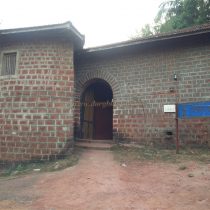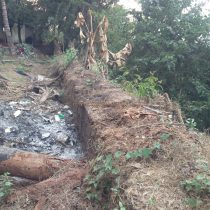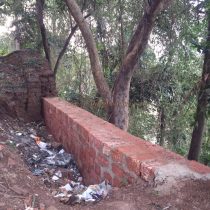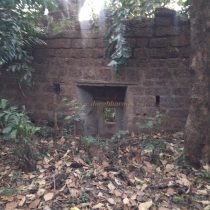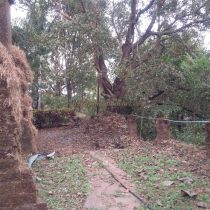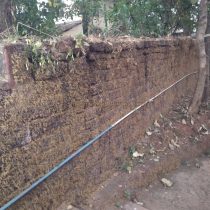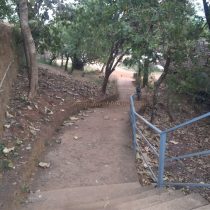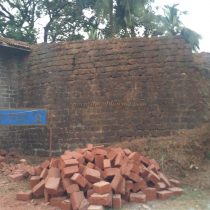BANDA
TYPE : COASTAL FORT
DISTRICT : SINDHUDURG
HEIGHT : 0
GRADE : EASY
Banda is the last village on the Maharashtra-Goa border on the Mumbai-Goa highway. Before the city of Sawantwadi came into existence, Banda was known as a port and market on the banks of the river Terekhol in the Kudal regime. The Terekhol River, which originates in the Amboli Ghat, travels 50 km and meets the sea at Terekhol. The town of Banda is situated on the banks of the river Terekhol, about 35 km from where it meets the sea. The goods coming to Banda port by the sea used to reach the country through Amboli Ghat. The Banda fort was built on the hill along the Terekhol river during or before the Adilshahi period to protect the port and the market. The distance from Mumbai to Banda is 504 km. Banda is at a distance of 15 km from Sawantwadi city.
...
Banda fort is not very familiar to the locals but since Banda police station is in the fort, if you ask the local people for the police station, you can easily reach the fort. The east-facing gate of the fort is built on the base of a bastion. This bastion and gate have been repaired in recent times. The construction of the gate bears some Portuguese imprint, and this bastion has a barrage for firing cannons and guns. The inner entrance of the bastion and the gate has a thatched roof and is used by the police station. Inside the gate, there is a closed barn with a guard room on the bastion. You enter the fort by climbing 10-12 steps through the closed passage inside the door. After climbing, in front, the temple you see is of Mahapurush, and on its right side is another bastion of the fort and behind it is the ramparts of the fort. When we come straight ahead, we come to the premises of the police station. There is a police station on the right side, the ramparts of the fort on the left side, and an old building in front. Steps are leading down from the left side of the ramparts, and the broken ramparts here may have had a small gate. The Pateshwar temple is on the right side of the old building in front and by entering the building you come to the back of the fort. Here you can see a quadrangle structure of a building. The bastion in this area has a window for cannons to shoot in the river basin and barrage in the ramparts for gunfire. This part of the fort is situated on the banks of the river Terekhol. This is where your half-hour fort round ends. The area of the fort is about one acre and since there is a police station in the fort, they have taken good care of the fort. As a police station is situated on the fort, you should first seek their permission to see the fort. While walking outside the fort, one can see the ramparts hidden in the trees. In the 14th century, the fort of Banda in the Vijayanagar Empire was conquered by the Bahamani Wazir Muhammad Gawan around 1470. After the establishment of the Bahmani kingdom, the city of Banda came under the control of Adilshah in 1490 and he renamed it Adilabad. During this period Banda fort was built or repaired. At the beginning of the 16th century, due to a feud between the Adilshah and the Portuguese, Viceroy Albuquerque attacked the city of Banda and pushed the Adilshahi army back to Kudal. An English letter mentions that Shivaji Maharaj came to Banda at around 15th June 1663. Between October and November 1664, Shivaji Maharaj defeated Khawaskhan and revolted the Adilshahis in the Kudal regime. During this period Banda province came under the control of Marathas. Aurangzeb’s son Akbar, who had come to the shelter of the Marathas, came to Banda on 3rd January 1683 to get ships and permission from the Portuguese to go to Mecca but returned to Rajapur after negotiations failed. After the death of Shivaji Maharaj, Banda city was burnt down by Aurangzeb’s son Shah Alam in May 1683 but due to the constant attack of the Marathas, Shah Alam got annoyed and returned. After that, the Marathas recaptured Banda. After the death of Sambhaji Maharaj, Khem Sawant of Sawantwadi joined the Mughals and with their help conquered Banda fort in June 1689. The Maratha kingdom was divided into two parts, Satara and Karveer. Sawant later built Terekhol fort on the mouth of Terekhol creek but in 1746 the fort was captured by the Portuguese. The importance of Banda fort diminished as long-range artillery from Terekhol fort began to control the ships entering Terekhol creek. Napanikar Nimbalkar's Sardar Apaji Subrao imprisoned Sawant in 1808 and also captured Banda and other places. In 1810, Chandroba Subhedar, Sardar of Sawant, defeated Subrao and captured Banda fort and later he became the fort keeper of this fort. In 1819, when William Grant Kerr, an English officer, attacked Sawantwadi, Chandroba Subhedar was disgraced and given ten thousand rupees and Banda Kot to remain neutral. In 1832, the Banda fort under Chandroba Subhedar was assigned an annual expenditure of Rs. 1249.
© Suresh Nimbalkar

